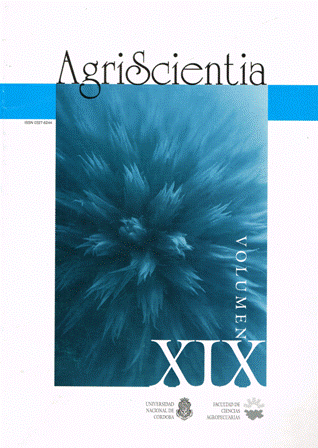Spike reproductive performance in hexaploid triticale (X Triticosecale Wittmack). Selective direct and correlated responses
Main Article Content
Abstract
The main objective of this study was to measure the effect of disruptive selection of number of seeds per spikelet on primordial and fertile florets in hexaploid triticale. A divergent selection scheme was used, choosing 15 F₂ plants with the highest and lowest spikelet fertility. During 1999, the thirty F₂:₅ families were sowed using one-row plots, 5 m long and 0.2 m apart, with 250 seeds/m². A significant direct response to selection was observed. The spike analysis by thirds showed significant changes only in the lower and middle thirds. The observed correlated responses with respect to the number of primordia and fertile florets per spikelet confirm that the plasticity of two or more characters is inversely proportional to their ontogenic proximity. From the definition of the terminal spikelet to the number of seeds determination, the number of seeds per spikelet plays an essential role as regards its positive effects on the preceding and succeeding determined traits.
Article Details
Issue
Section

This work is licensed under a Creative Commons Attribution-ShareAlike 4.0 International License.
How to Cite
References
Adams, M.W., 1967. Basis of yield component compensation in crop plants with special reference to the Field Bean, Phaseolus vulgaris. Crop Sci. 7:505-510.
Bonnett, O.T., 1983. Las inflorescencias de maíz, trigo, centeno, cebada y avena: su iniciación y desarrollo. Ed. Hemisferio Sur S.A. Argentina.
Cantrell, R.G. and E.S. Haro-Arias, 1986. Selection for spikelet fertility in semidwarf durum wheat population. Crop Sci. 26:691-693.
Cerana, M.M., S.P. Gil and R.H. Maich, 2002. Plant breeding scheme effects on the flower number and grain yield components in bread wheat. Cereal Res. Commun. 30(3-4):307-313.
Gallais, A., 1984. Use of indirect selection in plant breeding. In: Lange, W., Zeven, A.C. & N.G. Hogenboon (eds), Efficiency in plant breeding, Proc. 10th Congress Eucarpia, Pudoc, Wageningen, pp. 45-60.
Grafius, J.E., 1978. Multiple characters and correlated response. Crop Sci. 18:931-933.
Maich, R.H. and D. Manero de Zumelz, 1998. Spikelet fertility and meiotic index in hexaploid triticale. Realized heritabilities and correlated responses for agronomical traits. Cereal Res. Commun. 26(4):433-437.
Oettler, G., 1998. Creating genetic variability in triticale and its potential for breeding: 1. Agronomic traits. In: Juskiw, P. (Ed.), Proceedings of the 4th International triticale symposium, vol. 1, pp. 1-12. Alberta, Canada, July 26-31, 1998. International Triticale Association, Canada.
Siddique, K.H.M., E.J.M. Kirby and M.W. Perry, 1989. Ear-to-stem ratio in old and modern wheat; relationship with improvement in number of seeds per ear and yield. Field Crops Res. 21:59-74.
Slafer, G.A., E.H. Satorre and F.H. Andrade, 1994. Increases in grain yield in bread wheat from breeding and associated physiological changes. In: Slafer, G.A. (Ed.) Genetic improvement of field crops, M. Dekker, Inc., New York, pp. 1-68.





